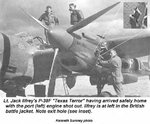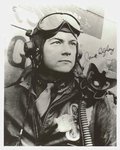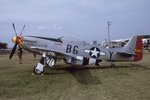Navigation
Install the app
How to install the app on iOS
Follow along with the video below to see how to install our site as a web app on your home screen.
Note: This feature may not be available in some browsers.
More options
You are using an out of date browser. It may not display this or other websites correctly.
You should upgrade or use an alternative browser.
You should upgrade or use an alternative browser.
p51 vs p47
- Thread starter brad
- Start date
Ad: This forum contains affiliate links to products on Amazon and eBay. More information in Terms and rules
More options
Who Replied?Lightning Guy
Master Sergeant
- 2,511
- Apr 29, 2004
Relative fragility of the P-38? I've never heard that before. P-38s were known to survive head-on collisions with enemy fighters and still return to base.
lesofprimus
Brigadier General
There are many reports where the propeller has come off the engine and severed the cockpit, and the pilot.....
2 engines aint always the best.....
2 engines aint always the best.....
A
Anonymous
Guest
The P-38 engines, and especially turbo-supercharger units which extend well back on the booms on the P-38 are very exposed and have practically no protection. The P-47 turbo-supercharger is less exposed, the maine turbine unit being fairly well protected and the tubing for its induction and intercooler systems being protected both by the double-thick alluminum of the P-47's general construction and some armor, and by the thickness of the fuselage in general. The main turbines of the P-38's turbo units are just sitting their exposed on the tops of the booms behind the engines and a prime targets for the most common type of deflection shots against a turning target.
Furthermore, until the late J, L and F-SB models , P-38's only had a generator on the left engine. If the engine with the generator was shot out, the other engine was running on battery power and was going to shut down as well as soon as the battery ran down.
Another issue was the drop tanks, which could be dropped when full at airspeeds up to 400 mph, but when empty could not be dropped above airspeeds of 160 mph without serious risk of damage as they may hit the tail or booms. Most other planes could drop empty tanks at any speed.
Finally, the R-2800 was much tougher than the Allison (or Merlin for that matter). R-2800 powered planes could take engine hits and still fly long distances home. Almost any hmg or cannon hit, and even most lmg hits, to a liquid cooled engine, or its cooling system, means that engine will be finished within 5 minutes or less. Even though the P-38 had two engines, it still would not fly as well as an R-2800 plane missing a couple of its 18 cylinders. Often when an Allison engine was taken out by enemy fire, it's prop could not be feathered, in which case the plane was flyable, but barely, and was not going far. And the area of exposure of the R-2800 was much much smaller than that of a liquid cooled engine and its radiator, so it was less likely to be hit in the first place.
I'm not saying the P-38 was fragile, just that it was no where near as rugged as the Corsair (which was the toughest fighter in WWII), or the P-47 (arguably the 2nd toughest, though the Tempest could also be argued for).
=S=
Lunatic
Furthermore, until the late J, L and F-SB models , P-38's only had a generator on the left engine. If the engine with the generator was shot out, the other engine was running on battery power and was going to shut down as well as soon as the battery ran down.
Another issue was the drop tanks, which could be dropped when full at airspeeds up to 400 mph, but when empty could not be dropped above airspeeds of 160 mph without serious risk of damage as they may hit the tail or booms. Most other planes could drop empty tanks at any speed.
Finally, the R-2800 was much tougher than the Allison (or Merlin for that matter). R-2800 powered planes could take engine hits and still fly long distances home. Almost any hmg or cannon hit, and even most lmg hits, to a liquid cooled engine, or its cooling system, means that engine will be finished within 5 minutes or less. Even though the P-38 had two engines, it still would not fly as well as an R-2800 plane missing a couple of its 18 cylinders. Often when an Allison engine was taken out by enemy fire, it's prop could not be feathered, in which case the plane was flyable, but barely, and was not going far. And the area of exposure of the R-2800 was much much smaller than that of a liquid cooled engine and its radiator, so it was less likely to be hit in the first place.
I'm not saying the P-38 was fragile, just that it was no where near as rugged as the Corsair (which was the toughest fighter in WWII), or the P-47 (arguably the 2nd toughest, though the Tempest could also be argued for).
=S=
Lunatic
wmaxt
Staff Sergeant
lesofprimus said:There are many reports where the propeller has come off the engine and severed the cockpit, and the pilot.....
2 engines aint always the best.....
Actually pretty rare, the phisics of the outward rotating props tend to throw them away from the pilot. I'm not saying it couldn't happen, I have heard where the supercharger turbine took out a pilot to. For many/ maybe most the second engine was a good thing. In combat all things are possible.
wmaxt
Staff Sergeant
RG_Lunatic said:The P-38 engines, and especially turbo-supercharger units which extend well back on the booms on the P-38 are very exposed and have practically no protection. The P-47 turbo-supercharger is less exposed, the maine turbine unit being fairly well protected and the tubing for its induction and intercooler systems being protected both by the double-thick alluminum of the P-47's general construction and some armor, and by the thickness of the fuselage in general. The main turbines of the P-38's turbo units are just sitting their exposed on the tops of the booms behind the engines and a prime targets for the most common type of deflection shots against a turning target.
Furthermore, until the late J, L and F-SB models , P-38's only had a generator on the left engine. If the engine with the generator was shot out, the other engine was running on battery power and was going to shut down as well as soon as the battery ran down.
Another issue was the drop tanks, which could be dropped when full at airspeeds up to 400 mph, but when empty could not be dropped above airspeeds of 160 mph without serious risk of damage as they may hit the tail or booms. Most other planes could drop empty tanks at any speed.
Finally, the R-2800 was much tougher than the Allison (or Merlin for that matter). R-2800 powered planes could take engine hits and still fly long distances home. Almost any hmg or cannon hit, and even most lmg hits, to a liquid cooled engine, or its cooling system, means that engine will be finished within 5 minutes or less. Even though the P-38 had two engines, it still would not fly as well as an R-2800 plane missing a couple of its 18 cylinders. Often when an Allison engine was taken out by enemy fire, it's prop could not be feathered, in which case the plane was flyable, but barely, and was not going far. And the area of exposure of the R-2800 was much much smaller than that of a liquid cooled engine and its radiator, so it was less likely to be hit in the first place.
I'm not saying the P-38 was fragile, just that it was no where near as rugged as the Corsair (which was the toughest fighter in WWII), or the P-47 (arguably the 2nd toughest, though the Tempest could also be argued for).
=S=
Lunatic
I think your overstating the vunerablbility of the P-38 a bit.
The drop tank limitation was for the 300/310 gal tanks.
The engine didn't shut down with the generator out (The magnetos generated their own power, all the engine needed to run) but the prop could go 'wild' with low battery voltage. The proceedure was to set the prop and shut down power as much as possible. It also helped if you went to a warmer altitude. I do agree the single generator was a bad idea, but not as bad as you infer.
The 2,800 was/is a great power plant and did fantastic things but was NOT twice as reliable as the Inline engines. There are stories of several cyl shot out and comming home - how many didn't? Let's keep it reasonable.
Lastly with cylinders shot out a 2,800 needed to be carefuly nursed home, damage to oil tank/oil lines/main bearings was instant death. The P-38 on one engine flew just fine up to and including rangees of 800mi, speeds over 300mph, on occasion engaging the enemy and any manuver desired. The only critical point was landing where the 500ft/120mph rules were absolute.
Lightning Guy
Master Sergeant
- 2,511
- Apr 29, 2004
On the P-38, the pilot was protected my armor on the inboard sides of the turbos. This provided protection from hurled blades. The alignment of engines and turbos also provided excellent protection for the pilot from flanking fire (and personally, I would much rather lose and engine that my life). Also, a P-47 with a shot up engine will not be continuing a fight. It will most likely be doing the same thing a one-engined P-38 would be doing, trying to make it home. An individual R-2800 was superior to an individual V-1710, but I'm not certain it was superior to two.
wmaxt
Staff Sergeant
Lightning Guy said:On the P-38, the pilot was protected my armor on the inboard sides of the turbos. This provided protection from hurled blades. The alignment of engines and turbos also provided excellent protection for the pilot from flanking fire (and personally, I would much rather lose and engine that my life). Also, a P-47 with a shot up engine will not be continuing a fight. It will most likely be doing the same thing a one-engined P-38 would be doing, trying to make it home. An individual R-2800 was superior to an individual V-1710, but I'm not certain it was superior to two.
FYI, The reference to the turbo incident was from Col. John Lowell in the book 'Top Guns" where he saw it happen.
I agree with you completly, in many, many stories of the P-38s tell of shot up engines and a trip home on one.
Ground attack especialy in the ETO was a very dangerous game.
An interesting Paper on relative silouet sizes (as large dimentionaly large as the P-38 is, it's front and side views are quite small) is in the "Planes and Pilots of WWII" website (I can't put the address here I don't know how to type the horizontal squigle that is contained in it, maybe someone can tell me how?).
A
Anonymous
Guest
Do you mean this page?
http://home.att.net/~ww2aircraft/Profiles.html
============================
BTW: the easiest way to copy a link to a post is to simply open the desired page in your browser, highlight the link in the address bar, hit ctrl+c to copy the link, then switch to the post you're editing and hit ctrl+v to paste the link into the post.
If you want to make a word (or phrase) a link, as in:
P-38 vs single engine profiles
it is a little more complicated. First copy the link as above into the post, then highlight it and click the "url" button in the post editor (above the text entry area). This will give you something like.... (using curly brackets in place of square brackets)
{url}http://home.att.net/~ww2aircraft/Profiles.html{/url}
then edit that to the following
{url=http://home.att.net/~ww2aircraft/Profiles.html}P-38 vs single engine profiles{/url}
putting the mouse over the URL button will show you the format. This is particularly useful for very large urls, espeically if you want to put them inline in the flow of the text.
Hope this helps.
=S=
Lunatic
http://home.att.net/~ww2aircraft/Profiles.html
============================
BTW: the easiest way to copy a link to a post is to simply open the desired page in your browser, highlight the link in the address bar, hit ctrl+c to copy the link, then switch to the post you're editing and hit ctrl+v to paste the link into the post.
If you want to make a word (or phrase) a link, as in:
P-38 vs single engine profiles
it is a little more complicated. First copy the link as above into the post, then highlight it and click the "url" button in the post editor (above the text entry area). This will give you something like.... (using curly brackets in place of square brackets)
{url}http://home.att.net/~ww2aircraft/Profiles.html{/url}
then edit that to the following
{url=http://home.att.net/~ww2aircraft/Profiles.html}P-38 vs single engine profiles{/url}
putting the mouse over the URL button will show you the format. This is particularly useful for very large urls, espeically if you want to put them inline in the flow of the text.
Hope this helps.
=S=
Lunatic
wmaxt
Staff Sergeant
RG_Lunatic said:Do you mean this page?
=S=
Lunatic
Yes That One. Thanks, I've been using computers in work settings since the mid-eighties but there are still things I'd like to know.
By the way, I Respect the width and breadth both of your knowledge and data, very impressive
wmaxt
A
Anonymous
Guest
wmaxt said:RG_Lunatic said:Do you mean this page?
=S=
Lunatic
Yes That One. Thanks, I've been using computers in work settings since the mid-eighties but there are still things I'd like to know.
By the way, I Respect the width and breadth both of your knowledge and data, very impressive, no puns intended, (I'm used to people coming to me) so I hope you don't take it personaly when I come back on something. I know I wont.
wmaxt
I wouldn't be here if I didn't enjoy a good debate. Most topics are mostly a matter of opinion anyway right?
=S=
Lunatic
wmaxt
Staff Sergeant
RG_Lunatic said:wmaxt said:RG_Lunatic said:Do you mean this page?
=S=
Lunatic
Yes That One. Thanks, I've been using computers in work settings since the mid-eighties but there are still things I'd like to know.
By the way, I Respect the width and breadth both of your knowledge and data, very impressive, no puns intended, (I'm used to people coming to me) so I hope you don't take it personaly when I come back on something. I know I wont.
wmaxt
I wouldn't be here if I didn't enjoy a good debate. Most topics are mostly a matter of opinion anyway right?

=S=
Lunatic
Ya!
Most especialy where aircraft of this performance level is concerned. In Any of the top fighter aircraft it was pilot mastery of capabilities, tactics and stratagy in relation to the other guy that determined the outcome. Everything in between is debatable
Erich
the old Sage
Nonskimmer
Captain
As you mentioned before Erich, the old timers are passing away fast. Natural, but a shame none the less. 
Lightning Guy
Master Sergeant
- 2,511
- Apr 29, 2004
Jack Ilfrey was the sterotypical fighter pilot. His life and experiences might make for a very good movie. Especially his escape from internment in Portugal.
A
Anonymous
Guest
Nonskimmer said:As you mentioned before Erich, the old timers are passing away fast. Natural, but a shame none the less.
My Dad passed away last May. I used to ask him about various planes, but his knowlege was mostly post-WWII.
I'd love to ask him what he thought of the Lightning. We spent over a year in Europe, mostly in England, while he taught NATO pilots how to fire air-to-air missiles. He spent some time attached to both the RAF and the RN and flew most planes, even a Spitfire and I think a SeaFury too.
=S=
Lunatic
wmaxt
Staff Sergeant
RG_Lunatic said:Nonskimmer said:As you mentioned before Erich, the old timers are passing away fast. Natural, but a shame none the less.
My Dad passed away last May. I used to ask him about various planes, but his knowlege was mostly post-WWII.
I'd love to ask him what he thought of the Lightning. We spent over a year in Europe, mostly in England, while he taught NATO pilots how to fire air-to-air missiles. He spent some time attached to both the RAF and the RN and flew most planes, even a Spitfire and I think a SeaFury too.
=S=
Lunatic
Sorry to hear that RG.
We will miss these men and women.
The Moxie of those men is incredable, can you imagine flying 2 people in a P-38 or P-51 cocpit? Jack did, I think that one was a P-51.
Erich
the old Sage
lesofprimus
Brigadier General
Chuck Yeagers ride.....
Erich
the old Sage
Users who are viewing this thread
Total: 1 (members: 0, guests: 1)
Similar threads
- Replies
- 0
- Views
- 2K




